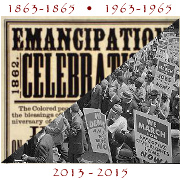“New England’s Scarlet ‘S’ for Slavery”
Posted March 16th, 2010 by James DeWolf PerryCategory: History Tags: Historical amnesia, Native Americans, New England
James DeWolf Perry is a regular guest contributor. He appears in the film Traces of the Trade and is the Tracing Center’s director of research. This entry originally appeared on James’ own blog, The Living Consequences, and the opinions expressed are his own.
 Slavery in New England was brutal and lasted, in its official form, for 150 years. Enslavement greatly enriched the colonists and, later, citizens of New England, and only died out gradually and fitfully.
Slavery in New England was brutal and lasted, in its official form, for 150 years. Enslavement greatly enriched the colonists and, later, citizens of New England, and only died out gradually and fitfully.
This is the proposition of an op-ed appearing in tomorrow’s Boston Globe, entitled “New England’s scarlet ‘S’ for slavery,” in honor of the birthday of Dr. Martin Luther King, Jr. The op-ed suggests that the northern states lag behind the South in acknowledging the difficult truths of race buried in our past, and that we cannot skip this step if we are to make progress on race relations.
The essay is written by C. S. Manegold, who is the author of Ten Hills Farm: The Forgotten History of Slavery in the North (2009), published last month by Princeton University Press.
Among the highlights of the brief history of New England slavery presented by Manegold:
- John Winthrop, the first governor of the Massachusetts Bay Colony and the man who associated the American colonies with the biblical phrase “a city upon a hill,” kept slaves and helped to write the first law in North America, in 1641, to officially sanction slavery
- The first slaves in New England were American Indians captured as prisoners of war and given out to white soldiers or allied Indian tribes. Black slavery, however, had reached the northern colonies long before the 1641 law allowing the practice
- Slavery in New England was not gentle. The example given by Manegold, from one of the earliest accounts of life in New England, is of a slave living near the present-day Logan Airport, who was ordered to rape another slave so that the owner could breed his own slaves
- As early as 1638, New England traders shipped American Indian slaves to the Caribbean in exchange for “cotton, and tobacco and Negroes”
- One of Governor Winthrop’s sons served as governor of Connecticut and owned black slaves on many properties, while another son served as lieutenant governor in Antigua and oversaw a large slave plantation
- Slavery in Massachusetts lasted until well after the American Revolution, when a little-noted court opinion began the long, slow process by which slavery died out gradually, “farm by farm, owner by owner”
- Harvard Law School was founded with money derived in part from slavery and slave-trading, and Barack Obama’s basement apartment in Somerville was located on land that had contained slaves for 150 years
Manegold notes that the historical amnesia of the North has been dramatically successful: today, slavery is associated primarily with the South, while the North conjures images of heroic patriots and staunch abolitionists, and perhaps the occasional “domestic servant” subject to mild treatment. This message is, of course, also at the heart of Traces of the Trade, and it has always been a central concern of this blog.
Manegold’s essay is based largely on her book, Ten Hills Farm, about the property originally owned by Governor Winthrop and the century and a half of slavery which took place there.
As a result, her brief summary of the history of slavery in New England omits several issues that I consider to be vital: she skips lightly over the gradual, half-hearted emancipation of northern slaves, and says nothing about the shocking “Negro removal” policies of the northern states after they no longer had need of their freed slaves. Manegold could also have mentioned how ambivalent the northern states were about slavery, and how profoundly intertwined their economies were with southern slavery, until the outbreak of the Civil War.
Most importantly, Manegold could have enlightened her readers about the extent to which the New England economy depended upon slavery. Not only were slavery and slave-trading substantial businesses in New England until the early 19th century, but the economy of colonial New England depended heavily on the trade to the West Indies, which involved supplying sugar plantations with agricultural products, lumber, livestock, and light manufactured goods, all of which the plantation owners were will to purchase at a premium in order to keep their land and slaves producing the “white gold” that brought such wealth to the West Indies in the 18th century. (This is the trade which President John Quincy Adams said was an “essential ingredient” in our independence, because it was essential in providing the colonies enough wealth to be able to revolt successfully against Great Britain.)
After the Revolution, meanwhile, and until the Civil War, the northern states profited heavily from southern cotton production, specializing in the financing, insurance, marketing, and transportation of the vast quantities of cotton which were eventually produced in the South, to the extent that most of the profits from southern cotton production flowed into the northern states. Finally, in the decades leading up to the Civil War, the northern states industrialized on the backs of southern slaves, turning the profits from northern slave-trading and southern slavery, along with inexpensive, slave-produced cotton, into the cotton textile industry which laid the foundation for U.S. economic development after the Civil War.
Despite what else she could have said, Manegold has written a powerful essay, and I believe she has chosen a highly suitable occasion. She quotes Dr. King, at the start of her essay, as follows:
Nothing in all the world is more dangerous than sincere ignorance and conscientious stupidity.
This is indeed, it seems to me, the primary reason why we must re-learn what New Englanders understood until well into the 20th century, that slavery was an integral part of the region’s past and how it became what it is today. As Manegold writes:
as King suggested, responsible dialogue can not move forward with half-truths and willful ignorance. In this regard, the North has work to do. It lags behind the South in stepping up to ugly truths.



Leave a Reply